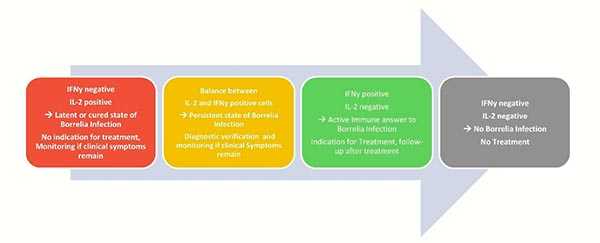
Borrelia iSpot
€265.00
Lyme iSpot - determination of cellular immune response in Borrelia burgdorferi infections.
This test can distinguish between active (specific effector cells) and latent (specific memory cells) infections. Thus, infection, inflammation and autoimmune processes can now be better evaluated.

While EliSpot is based solely on interferon γ (IFN-gamma) production, Lyme iSpot also detects the cytokine IL-2. IFN-gamma and IL2 cytokine responses are measured using a "stimulation index" (SI). If interferon gamma is positive in iSpot (SI 2-3 weakly positive, >3 positive), this indicates that the sample contains effector T cells responding to B. burgdorferi and the patient likely has an active infection. This indicates that therapy with antimicrobial protocols is appropriate.
If IL2 iSpot is positive (same SI reference ranges), this indicates the presence of Lyme-specific memory cells, i.e. indicates immune memory for past infection, but is also considered a "latent" signal.
The doctor should make treatment decisions based on the patient's symptoms. The value of iSpot is that it gives you more information about the patient's immune system response.
Lyme iSpot - Identifying the cellular immune response in Borrelia burgdorferi infections.
The Lyme iSpot provides information on the activity of a potential Borrelia burgdorferi infection.
This test can differentiate between active (specific effector cells) and latent (specific memory cells)
infections. Due to the EliSpot (Enzyme-linked immunosorbent spot assay), it is now possible to
better evaluate infection, inflammation, and autoimmune processes.
While the EliSpot is exclusively based on interferon γ production, the Lyme iSpot also determines the
the cytokine IL-2. The IFN gamma and IL2 cytokine responses are measured using a "stimulation
index" (SI). If the IFN gamma iSpot is positive (SI of 2-3 is weakly positive, >3 is positive), this
indicates that the sample contains effector T cells that are reactive to B. burgdorferi, and the
patient is most likely to have an active infection.
This suggests the advisability of therapy with
antimicrobial protocols. If the IL2 iSpot is positive (same SI reference ranges), this indicates the
presence of Lyme-specific memory cells. This indicates immune memory to past infection but is
also considered a "latent" signal.
The decision as to whether to treat should be taken considering a
patient's symptoms. The value of the iSpot is that it gives you two different perspectives on the
reaction of the patient's immune system
| Method | ISpot |
|---|---|
| Tubes | 3 x ACD/CPDA |